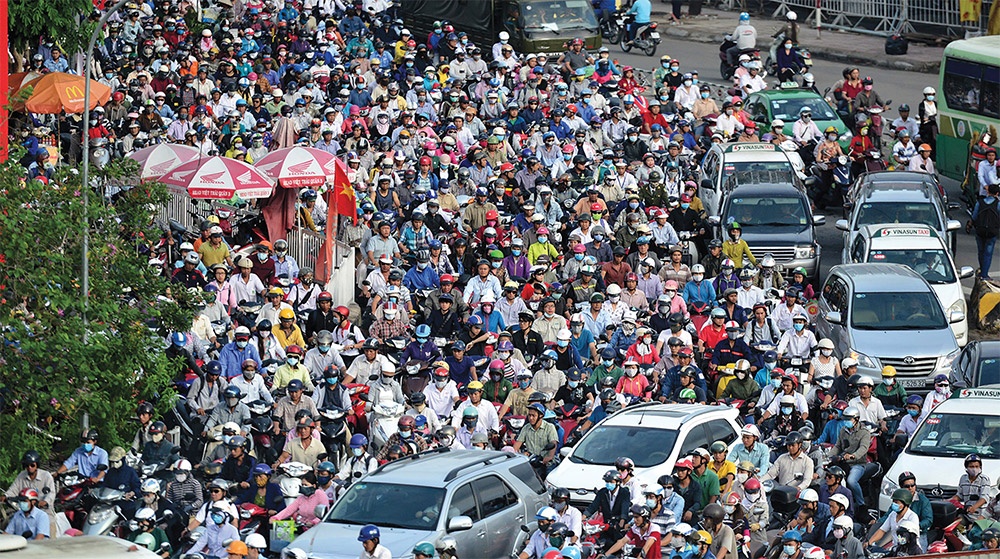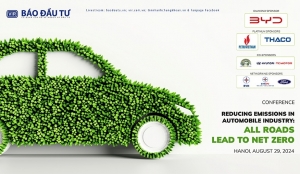Emissions standards for vehicles to rise
The ministry (MoT) is seeking comments from other ministries on a draft decree regulating emissions inspection services for motorcycles and scooters at emissions inspection centres. Under it, motorcycles and mopeds must be granted a stamp certifying that they meet emission standards before they can participate in traffic. Motorcycle emission inspection facilities will be the location to conduct the inspection and issue the stamp.
 |
| There are at least 7.7 million motorbikes in Hanoi and closer to nine million in Ho Chi Minh City, Photo Le Toan |
Regarding emission testing fees, according to calculations by the MoT, people may only have to pay VND35,000 ($1.40) per year. Organisations with certificates proving their eligibility to operate emissions inspection services for motorcycles and scooters will be allowed to conduct inspections.
Nguyen Van Thanh, former chairman of the Vietnam Transport Association, said that urban environmental pollution is currently at an alarming level. Along with greenhouse gas emissions, emissions from motor vehicles, including motorbikes, are one of the main causes of urban environmental pollution.
“To reduce this situation, it is necessary to apply regulations on emission inspection for motorbikes. However, the drafting agency needs to stipulate the implementation roadmap. To control emissions, the agencies need to have policies to support and convert to newer vehicles,” he said.
Nguyen To An, deputy director of the Vietnam Register, explained that the new Law on Traffic and Safety will take effect from January 1, 2025, but that does not mean that all motorbikes and scooters nationwide will have to have their emissions inspected from that date.
“Specifically, the law provides regulations, but the implementation time depends on the implementation roadmap issued by the government,” An said.
He added that this roadmap would be developed by the Ministry of Natural Resources and Environment, in coordination with the MoT, and submitted to the government.
“The decision will issue a complete roadmap, applicable standards, and implementation methods. However, the general spirit is that newly imported and assembled vehicles are already being controlled for emissions. Only old vehicles participating in traffic are not yet controlled,” An said.
Currently, emission standards for road motor vehicles are only applied to newly manufactured, assembled, imported two-wheeled cars and motorbikes, cars in traffic and imported used cars. They are not yet applied to motorbikes in traffic because the 2008 Road Traffic Law has not regulated them.
Nguyen Xuan Thuy, an urban traffic expert, said that although emissions from vehicles are polluting the urban air environment, it is not necessary to force all motorbikes in circulation to undergo periodic emission inspections.
“Hanoi has over 7.7 million motorbikes and Ho Chi Minh City has about nine million motorbikes, and so it is not realistic to inspect all of them. In addition, motorbike inspections also need to be put in the context of each locality, and it is impossible to issue a general regulation for the whole country to implement,” Thuy said.
“Inspections should only be conducted in cities with high population density. For example, cities with a population of 300,000-500,000 people or more can implement the policy,” he added.
Vietnam currently has over 60 million motorbikes, accounting for over 90 per cent of all vehicles. According to statistics from the Vietnam Association of Motorcycle Manufacturers, in the first half of 2024, more than 1.2 million motorbikes were sold nationwide. Vietnam is the country with the second-largest number of motorbikes in the Southeast Asian region, following Indonesia.
 | Supporting a green strategy for the automotive industry With 6.5 million cars and 74 million motorcycles, Vietnam is the second-largest emitter of greenhouse gases (GHGs) from road transport in Southeast Asia, following Indonesia. Emissions from road vehicles in the country are rising rapidly, with an average annual increase of about 15 per cent over the past decade. |
What the stars mean:
★ Poor ★ ★ Promising ★★★ Good ★★★★ Very good ★★★★★ Exceptional
Related Contents
Latest News
More News
- Businesses ramp up production as year-end orders surge (December 30, 2025 | 10:05)
- Vietjet chairwoman awarded Labour Hero title (December 29, 2025 | 13:06)
- How to unlock ESG value through green innovation (December 29, 2025 | 10:03)
- AI reshapes media and advertising industry (December 29, 2025 | 08:33)
- FPT and GELEX sign deal to develop blockchain tech for global markets (December 29, 2025 | 08:29)
- Vietnam’s GDP forecast to grow by 9 per cent in 2026 (December 29, 2025 | 08:29)
- Women entrepreneurs are key to Vietnam’s economic growth (December 29, 2025 | 08:00)
- Vietnam's top 500 value-creating enterprises announced (December 27, 2025 | 08:00)
- The PAN Group shaping a better future with ESG strategy (December 26, 2025 | 09:00)
- Masan Consumer officially lists on HSX, marking the next phase of value creation (December 25, 2025 | 13:20)

 Tag:
Tag:




















 Mobile Version
Mobile Version